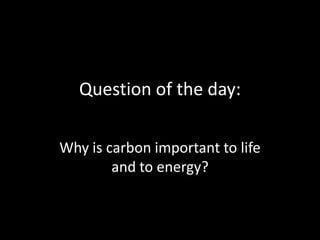
03 Introduction to Carbon Cycle
- 1. Question of the day: Why is carbon important to life and to energy?
- 2. Overview • Basics of Carbon – What is carbon – How it is used biologically • How is carbon cycled – Photosynthesis – Respiration – Sequestration – Sinks – Balance of the cycle • Human intervention – Burning of fossil fuels – Removal of sinks – Disruption of balance
- 3. What is Carbon? • The most important element for life on Earth • Backbone of organic molecules • Storage and transfer of energy
- 4. Where did this biomass come from?
- 5. Organic molecules game • What is the most complicated structure you can make? – Use all bonds and all atoms CO2 H2O
- 6. Glucose
- 7. Cellulose
- 8. Caffeine
- 9. DNA
- 10. Photosynthesis 6 CO2 + 6 H2O Photosynthesis C6H12O6 + 6 O2 Carbon dioxide from Water Organic the atmosphere matter Oxygen
- 11. Respiration: using energy stored in organic carbon C6H12O6 + 6 O2 6 CO2 + 6 H2O Respiration Organic Carbon dioxide Water Oxygen matter released to atmosphere
- 13. Back to the tree… • ~50% water by weight • ~45% dry weight is C in organic matter – Most of remainder is O, H in organic compounds • Organic matter is rich in C-C and C-H bonds, which release energy when broken • Organic carbon is used as energy ‘currency’ – it can be used immediately, stored, or transferred to other organisms
- 14. Fossil fuels • “Fossil” or ancient biomass • Formed because of incomplete decomposition of dead organisms (mostly algae and plants), under pressure Coal Oil Natural gas (methane)
- 17. Show Formation of Fossil Fuels from Earth: the Operator’s Manual
- 18. Burning any kind of organic carbon, including fossil fuels, releases energy and carbon dioxide We are burning fossil fuels about a million times faster than they were formed.
- 19. Respiration vs. burning fossil fuels • Both convert organic carbon and O2 to CO2 and H2O • Show “Now is the Time” or Competitive Enterprise Institute’s PSA
- 20. Carbon footprint exercise • http://calc.zerofootprint.net/youth/iEarn • http://footprint.stanford.edu/index.html • http://www.wattzon.com/
- 21. CO2 backpack • What would it feel like if you had to carry around the weight of your emissions?
- 22. Convert from tons/year to pounds /day • 1 metric ton = 2205 pounds • 1 year = 365 days • so 1 ton/year = 6.04 pounds/day
Hinweis der Redaktion
- Give them CO2 and H2O molecules Debrief: what did you come up with?How similar are they to each other?Did anything surprise you?How many C-C or C-H bonds did you come up with? These bonds are important because breaking them releases energy that can be used by organisms (or for human society)
- glucose
- Linked glucose units
- What about human respiration?Breathing produces approximately 2.3 pounds (1 kg) of carbon dioxide per day per person.You exhale about 365 kg (0.365 tons, or 803 lbs) CO2 each year.If you stop breathing, will it solve the CO2 problem?
- Average American emits